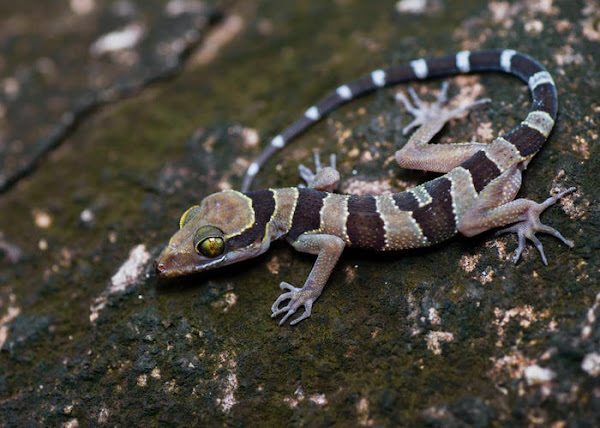Cyrtodactylus lekaguli (Lekagul's Bent-toed Gecko)
The common name of this Gecko Lizard in English is commonly called Lekagul's Bent-toed Gecko, Malayan Forest Gecko, Banded Bent-toed Gecko, Tukgai Boonsong Bent-toed Gecko, Boonsong's Bent-toed Gecko and Thai name called ตุ๊กกายหมอบุญส่ง (Tukgai Mor Bunsong), ตุ๊กกายบุญส่ง (Tukgai Bunsong).
ตุ๊กกายหมอบุญส่ง : Cyrtodactylus lekaguli Grismer, Wood Jr, Quah, Anuar, Muin, Sumontha, Ahmad, Bauer, Wangkulangkul, Grismer & Pauwels, 2012
Cyrtodactylus lekaguli is a species of the Bent-toed Gecko Genus (Cyrtodactylus) within the Gecko Lizard Family (Gekkonidae), Superfamily Gekkota, in the Lizard and Snake Order (Squamata), in the Reptile Class (Reptilia), in the Chordate Phylum (Chordata) in the Animal Kingdom (Animalia).
Published in Grismer, L.L.; Perry L. Wood, Jr., Evan S. H. Quah, Shahrul Anuar, Mohd. Abdul Muin, Montri Sumontha, Norhayati Ahmad, Aaron M. Bauer, Sansareeya Wangkulangkul, Jesse L. Grismer & Olivier S. G. Pauwels. A phylogeny and taxonomy of the Thai-Malay Peninsula Bent-toed Gecko of the Cyrtodactylus pulchellus complex (Squamata: Gekkonidae): combined morphological and molecular analyses with descriptions of seven new species. Zootaxa 3520: 1–55. (2012).
The specific epithet "lekaguli" honors Dr. Boonsong Lekagul (1907–1992), biologist and conservationist of Thailand and the first biologist to suggest the Thai common name "Tuk-Kai"(ตุ๊กกาย) for gecko of the genus Cyrtodactylus (Lekagul 1977).
This species has been considered as Cyrtodactylus pulchellus previously.
Geographic Range
This species is known from Khao Chong waterfall, Khao Chamao, Trang Provinc;, from Petch Phanomwung Cave, Kanchanadit District, Surat Thani Province; Krabi, Krabi Province; from Suwankuha Cave, Phung Chang Cave, Tham Phung Chang Cave; and from limestone formations surrounding Phang-nga City, Muang District, Phang-nga Province, Thailand (Grismer et al. 2012).
It has also been found in Khao Sok National Park in Surat Thani (reported in Klong Naka Wildklife Sanctuary 2002, as Cyrtodactylus pulchellus - M. Sumontha pers. comm. 2017).
Habitat and Ecology
This species has been found on tree trunks in the forest near streams, in the crevices of trees and in houses, in association with karst boulders and caves (Grismer et al. 2012). Two female specimens were collected in 2000 by Pauwels et al. (2000), each of them containing two eggs.
Type locality: Khao Chong waterfall, Khao Chamao, Trang Province, Thailand at approximately 07°35.28 N, 99°50.25 E at 165 meters elevation as estimated from Google Earth
Diagnosis
- Adult males reaching 103.5 mm SVL, adult females reaching 97.3 mm SVL;
- 10–12 supralabials, 9–11 infralabials;
- tubercles of dorsum moderate, with no intervening smaller tubercles;
- no tubercles on ventral surfaces of forelimbs, gular region, or in ventrolateral body fold;
- 30–50 paravertebral tubercles;
- 20–24 longitudinal rows of dorsal tubercles;
- 31–43 rows of ventral scales; 20–25 subdigital lamellae on fourth toe;
- 30–36 femoro- precloacal pores in males;
- dorsum not bearing a scattered pattern of white tubercles;
- four or five dark body bands in adults lacking lightened centers and light colored tubercles; body band to interspace ratio 1.00–2.00; 12–14 dark caudal bands;
- and white caudal bands infused with dark coloration and the posterior portion of the tail in hatchlings and juveniles is white.
